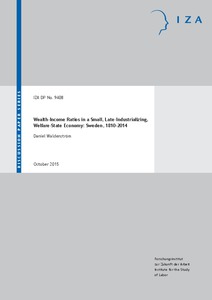Wealth-income ratios in a small, late-industrializing, welfare-state economy: Sweden, 1810–2014
"This paper uses new data on Swedish national wealth over a period of two hundred years to study whether the patterns in wealth-income ratios previously found by Piketty and Zucman (2014) for some very rich and large Western economies extend to smaller countries that were historically backward...
| Main Author: | |
|---|---|
| Institution: | ETUI-European Trade Union Institute |
| Format: | TEXT |
| Language: | English |
| Published: |
Bonn
2015
IZA |
| Subjects: | |
| Online Access: | https://www.labourline.org/KENTIKA-19109433124919276159-Wealth-income-ratios-in-a-smal.htm |
| Summary: | "This paper uses new data on Swedish national wealth over a period of two hundred years to study whether the patterns in wealth-income ratios previously found by Piketty and Zucman (2014) for some very rich and large Western economies extend to smaller countries that were historically backward and developed a different set of political and economic institutions during the twentieth century. The findings point to both similarities and differences. In the pre-industrial era, Sweden had much lower wealth levels than the rest of Europe, and the main explanation is that the Swedes were too poor to save their income. Over the twentieth century, Swedish aggregate trends and levels are much more similar to those of the rest of Europe, but the structure of national wealth differs. In Sweden, government wealth grew much faster and became more important, not least through its relatively large public pension system. This suggests an explicit role of historical economic and political institutions for the long-run evolution of wealth-income ratios." |
|---|---|
| Physical Description: | 45 p. Digital |

